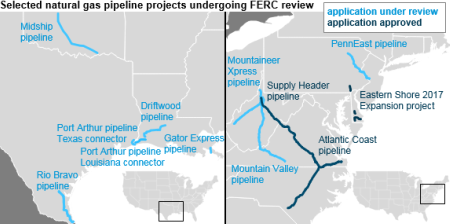FERC regains ability to certificate natgas pipelines
Three new pipeline projects in the northeast received approval from the Federal Energy Regulatory Commission (FERC) in October, the first projects to be approved since February.
FERC regained its quorum in August after the Senate confirmed two new commissioners. These confirmations ended a six-month period when FERC was unable to issue certificates to allow construction of interstate energy transmission infrastructure, including natural gas pipeline projects. FERC did not have a quorum beginning in February 2017 when the number of commissioners fell below the required minimum of three. The final two commissioners await a floor vote by the Senate.
 |
| Courtesy of EIA. |
The three projects approved in October, which are designed to increase the delivery capacity from the Northeast’s Utica and Marcellus natural gas-producing regions, are:
- Supply Header Pipeline: a 1.5 Bcfd, 38-mi pipeline from West Virginia to Pennsylvania
- Atlantic Coast Pipeline: a 1.5 Bcfd, 600-mi pipeline from West Virginia to North Carolina
- Eastern Shore 2017 Expansion Project: 40 mi in pipeline expansions, providing 0.061 Bcfd from Pennsylvania to Delaware.
Before losing its quorum on Feb. 3, FERC had certificated more than 7 Bcfd of pipeline capacity. Since then, as of Oct. 24, 12 pre-filing applications have been submitted to FERC for pipeline projects transmitting natural gas in the United States and 50 pipeline projects have FERC applications in process. The capacity of all these projects totals about 43 Bcfd, covering slightly less than 3,000 mi of both new and upgraded pipeline construction. In comparison, the Lower 48 states have more than 300,000 mi of interstate and intrastate natural gas transmission pipeline in use.
The nine largest projects by capacity with applications before FERC have a total capacity of slightly more than 21 Bcfd, or 63% of the capacity for all pending natural gas pipeline applications. Six of these projects, located in Texas, Louisiana, and Oklahoma, are intended to support LNG export projects. The construction of five of these pipeline projects will likely be tied to the approval of the associated LNG export terminals. These projects include:
- Rio Bravo Pipeline: a 137-mi pipeline in Texas with a capacity of 4.5 Bcfd, connecting the Rio Grande LNG facility to available interstate pipelines
- Driftwood Pipeline: a 96-mi pipeline in Louisiana with a capacity of 4 Bcfd, connecting the Driftwood LNG facility to available interstate pipelines
- Port Arthur Pipeline–Louisiana Connector: a 135-mi pipeline with a capacity of 2 Bcfd, mostly in Louisiana with a small segment of pipeline in Texas to connect to the Port Arthur LNG facility in Texas
- Port Arthur Pipeline–Texas Connector: a 34-mi pipeline with a capacity of 2 Bcfd, mostly in Texas with a small segment of pipeline in Louisiana, terminating at the Port Arthur LNG facility in Texas
- Gator Express Pipeline: a 27-mi pipeline in Louisiana with a capacity of 1.9 Bcfd, connecting the Plaquemines LNG facility to the Tennessee Gas pipeline and the Texas Eastern Transmission pipeline.
In addition, the proposed Cheniere Midship Pipeline in Oklahoma is a 199-mi pipeline, with a capacity of 1.4 Bcfd, that would connect to pipelines that support Cheniere’s export facilities and provide natural gas to consumers along the Gulf Coast.
Three other relatively large proposed pipeline projects would further increase the delivery capacity from natural gas-producing regions in the northeast. These projects include:
- Mountaineer XPress Pipeline: a 2.7 Bcfd, 165-mi pipeline in West Virginia
- Mountain Valley Pipeline: a 2 Bcfd, 303-mi pipeline from West Virginia to Virginia
- PennEast Pipeline: a 1 Bcfd, 120-mi pipeline from Pennsylvania to New Jersey.

- ExxonMobil halts 1-Bft3d blue hydrogen project in Texas
- Aramco and Yokogawa commission multiple autonomous control AI agents at Fadhili gas plant
- Ukraine will resume gas imports via Transbalkan route in November
- Mitsubishi to inject $260 MM into Brunei LNG project
- Emerson’s new tank monitoring hub optimizes inventory management and operational efficiency



Comments